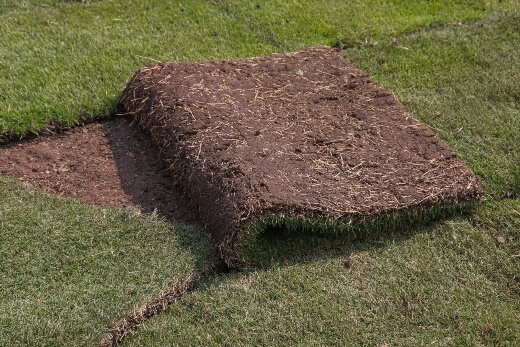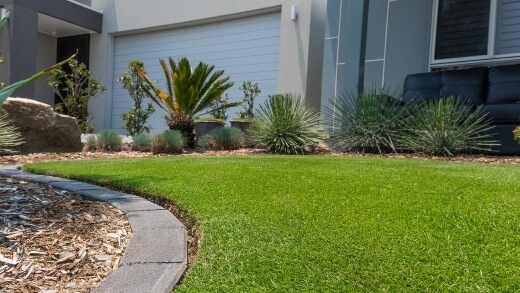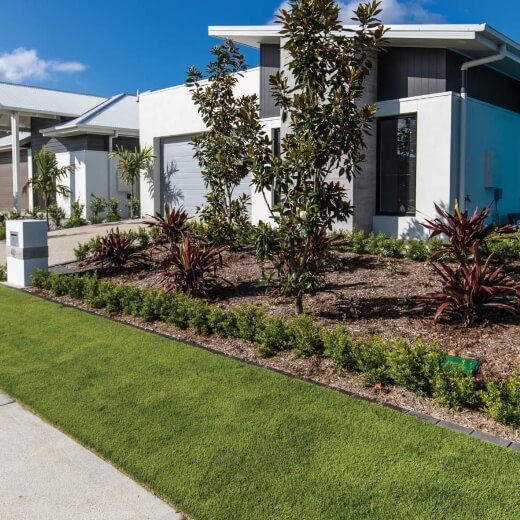Sir Grange Zoysia is a fine leafed turf variety needing as little as 3 hours of direct sunlight daily. A slow-growing variety, Sir Grange requires 50% less mowing and 75% less fertiliser than other varieties of turf.
In this article, you'll learn how to install and maintain Sir Grange Zoysia Turf.
More...
With Sir Grange Zoysia you can let it grow as long as 100mm or manicure it down to 8mm to look like a golf course finish, it is the ultimate luxury lawn.
Great for shaded areas, it is also perfect for full sun. Sir Grange Zoysia has a deep root network, with vigorous rhizome growth and high stolon frequency.

Sir Grange Zoysia Turf Installation
During the summer months, Australia's weather can be hot and harsh. The winter months are cold and freezing. Even though turf can be installed during the spring, the best time to do so is in Autumn.
When you lay turf in the Autumn, the grass is still growing, and the temperatures are cooler. This helps eliminate heat stress and improve the survivability rate.
It also provides the grass the time it needs to develop before summer. If you live in South-East Queensland, you can install turf all year round.
Ground Preparation
Before you can install turf, the surface area needs to be prepped. It is crucial you get rid of all the weeds and grass before preparing the soil. To kill the weeds/grass, use a broad-spectrum systemic herbicide.
When using any type of herbicide, make sure to read the instructions thoroughly. You will need to properly mix the herbicide, and you will also need to wear the appropriate personal protective equipment.
Here is our review on the best weed killers on the market to help you decide which would best work for your garden. After application of the herbicide, wait for at least 7 to 10 days. If there are still weeds and grass present, apply a second coat.
If you have an existing lawn that needs to be removed, you might need to remove the existing turf with a turf. Or you can also use a rotary hoe (which is available to hire).
Once the existing turf is removed, the area needs to be cultivated. To do this, you will need to remove any stones or other debris while digging out to a depth of 150 mm.

Adding Fresh Soil
Having fresh soil is crucial for having a healthy lawn. You do not have to wait to install fresh soil. When spreading out soil, you will often want to lay it 100 mm deep. Sometimes this may not be possible. It will all depend on the site itself.
You will need to do a little math to determine how much soil you will need. To determine how much soil to bring in, figure 2m³ of soil for every 20m² of turf area.


Get Your Free Guide:
Master Growing Australian Natives eBook
A Must Have Complete Guide for Every Australian Garden
Get Your Free Guide:
Master Growing Australian Natives eBook
A Must Have Complete Guide for Every Australian Garden
After installing the soil, level it out with a rake. The soil should sit 75 mm below weep holes to comply with building regulations. We recommend placing sandy loam soil under your new turf. It is great soil that allows for drainage and permits the roots to grow deep.
This, in turn, leads to a more drought tolerant lawn. The better the dirt foundation you lay, the better your result will be.
Planning the Space
When planning for new turf, sketch out the area. This will give you the ability to see exactly what you are looking at. Make sure to get the exact measurements since these are critical.
Once you have the area sketch up, you can easily calculate how much herbicide, dirt, and turf you will need,

Handling and Laying the Turf
Now that you have the area prepped and ready for turf, it is time to lay it. Turf is harvested in rolls or slabs. The turf is flexible yet extremely heavy. We recommend that you fold it to make it easier to handle.
This will help prevent the pieces from breaking apart, and it will be easier for you to carry. Start laying the turf around the perimeter of the area. Do this by unfolding or unrolling one large piece. Continue working your way around the perimeter.
You do not want to use small pieces around the perimeter unless absolutely necessary. Smaller pieces are susceptible to drying out and dying. After you have the perimeter laid, work your way strip by strip from the longest run.
Lay each strip against the other. They should touch each other without leaving a gap or overlapping. Be careful not to pull on the turf and stretch it. If you have any pieces that are overlapping, use a sharp knife to cut off the overlapping area.
Stay Off the Lawn
Once the new turf is laid, you will want to stay off it for 2 to 3 weeks. If you walk on the turf too early, you can damage the roots and disturb the rooting process.
Sir Grange Zoysia Maintenance

Watering Sir Grange Zoysia
Whilst establishing we recommend watering Sir Grange to this schedule:
Note: Your lawn should receive a minimum of 10/15mm per application
- Weeks 1 & 2: Water deeply 1-2 times daily.
- Weeks 3 & 4: Water deeply every second day.
- Weeks 5 & 6: Water deeply twice a week.
- Week 7 onwards: Water deeply regularly.
Mowing Sir Grange
Sir Grange can be left long or short depending on what you are trying to achieve. You can let it grow to 100mm around garden edges and mow it down to as little as 8mm to allow for variety or have it all long or all short. The possibilities are endless.
Author bio:
Jimboomba Turf is focused on providing, motivating and inspiring people to get the best quality turf solutions for their everyday needs. We have been in the turf game since 1973 and we are as young as we were back then.
With phenomenal turf varieties like Sir Grange Zoysia, TifTuf Bermuda, Sir Walter DNA Certified and Nullarbor Couch we have the perfect turf variety for every situation.
We don’t just supply turf for families alone, we pride ourselves on developing innovative products to satisfy the requirements of our residential, commercial and sporting clients. We remain the trusted name in the industry in South East Queensland.
Concluding Our Sir Grange Zoysia Turf Guide
Once you have your Sir Grange Zoysia Turf installed, remember the less walking on it the better. Your grass needs time to take root and grow. If you disturb the turf too much, it will lead to damage and an unsightly lawn.
After the turf has rooted and connected to the soil, look into starting a good fertiliser program. Fertiliser and regular watering will be the key to keeping your lawn looking thick and green.
Turf installation is the quickest way to cover your yard and improve its appearance. Now that you know how easy it is to install Sir Grange Zoysia turf, it is time to improve your yard.
Published on October 21, 2021 by Gary Clarke
Last Updated on February 21, 2025




